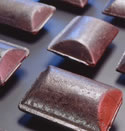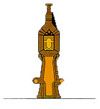|
Sections |
Our product |
The chemical and
physical characteristics |
|
|
 Orinoco
Iron briquettes are produced by reducing iron ore fines
in fluid bed reactors with a counter current reducing gas (Fluidized
Iron Ore Reduction). Due to their high density and
metallization, low gangue and residual content, and inert
character, Orinoco Iron HBI is the ideal metallic
charge for steelmaking. Orinoco
Iron briquettes are produced by reducing iron ore fines
in fluid bed reactors with a counter current reducing gas (Fluidized
Iron Ore Reduction). Due to their high density and
metallization, low gangue and residual content, and inert
character, Orinoco Iron HBI is the ideal metallic
charge for steelmaking.
Physical and chemical specifications of Orinoco Iron HBI
make a superior product for the merchant HBI/DRI market, as
a result of a low level of fines generated during
transportation and handling, as well as less gangue, higher
carbon, and higher metallization than that found in other
HBI/DRI products. |
|
Chemical Analysis |
| Total Fe |
92.5 % min |
|
Metallic Fe |
84 % min |
|
C |
0.8 - 1.5 % |
| P |
0.09 % max |
|
S |
0.03 % max |
| SiO2 (Silice) |
1.5 % max |
|
MgO |
0.3 % max |
| CaO |
0.03 % max |
|
Al2O3 (Alumina) |
1.3 % max |
Gangue (CaO+MgO+
SiO2+Al2O3) |
3.0 % max |
|
| |
|
Residual |
| Cu |
<=0.002% |
|
Ni |
<=0.006% |
| Cr |
<=0.008% |
|
Mo |
<=0.002% |
| Sn |
<=0.002% |
|
| |
|
Physical analysis |
| Size |
90 x 58 x 29
mm |
|
Weight |
0.5 - 0.7 Kgs |
| Bulk Density |
2.77
ton/M3 min |
|
Briquette
density |
5.0 g / cm3 |
|
Granulometric distribution |
>4 mm :
98%
<4 mm : 2% |
|
Moisture |
0.1% max. |
|
|
|
Specific
Applications |
|
Use in Electric Arc Furnaces |
 Due
to their high density, Orinoco Iron briquettes can
be used as an alternative metallic source by either
charging in buckets (batch charging) or continuous
feeding through the roof. By charging in buckets, it
is possible to reduce the number of back-charges
since briquettes are much denser than scrap. Up to
40% briquettes can be used when charging in buckets.
In continuous feeding, briquettes are more effective
than DRI due to their high density, which allows
them to penetrate to the slag/metal interface
quickly rather than hang up in the slag. It is
possible to continuously charge up to 100%
briquettes. One of the meltshops in the SIDETUR
group, Casima, uses an 85% briquette practice. By
continuous feeding, all back-charges can be
eliminated, which reduces tap to tap time and heat
losses due to swinging the roof. This results in a
more constant power input, which reduces line losses
and improves productivity. Because of the low
residual content of the briquettes, they are in
increased demand for the production of higher
quality steels. Due
to their high density, Orinoco Iron briquettes can
be used as an alternative metallic source by either
charging in buckets (batch charging) or continuous
feeding through the roof. By charging in buckets, it
is possible to reduce the number of back-charges
since briquettes are much denser than scrap. Up to
40% briquettes can be used when charging in buckets.
In continuous feeding, briquettes are more effective
than DRI due to their high density, which allows
them to penetrate to the slag/metal interface
quickly rather than hang up in the slag. It is
possible to continuously charge up to 100%
briquettes. One of the meltshops in the SIDETUR
group, Casima, uses an 85% briquette practice. By
continuous feeding, all back-charges can be
eliminated, which reduces tap to tap time and heat
losses due to swinging the roof. This results in a
more constant power input, which reduces line losses
and improves productivity. Because of the low
residual content of the briquettes, they are in
increased demand for the production of higher
quality steels. |
| |
|
Use in Ladle Furnaces |
 The
low residual content, compact shape, and high
thermal conductivity make briquettes attractive as a
coolant for liquid steel in ladle furnaces. The
low residual content, compact shape, and high
thermal conductivity make briquettes attractive as a
coolant for liquid steel in ladle furnaces. |
| |
|
Use in BOF |
 The
Orinoco Iron HBI are used as a replacement for oxide
pellets as coolant in BOFS to increase hot metal
production. Up to 5% briquettes have been used as
coolant in large BOF shops. They can also be used as
a trim coolant in ladles. HBI has been used in BOFs
as a high quality low residual scrap substitute with
excellent results. The
Orinoco Iron HBI are used as a replacement for oxide
pellets as coolant in BOFS to increase hot metal
production. Up to 5% briquettes have been used as
coolant in large BOF shops. They can also be used as
a trim coolant in ladles. HBI has been used in BOFs
as a high quality low residual scrap substitute with
excellent results. |
| |
|
Use in Blast Furnaces |
 Using
The Orinoco Iron HBI in the burden of blast furnaces
allows the productivity to be increased and reduces
coke consumption. Using
The Orinoco Iron HBI in the burden of blast furnaces
allows the productivity to be increased and reduces
coke consumption. |
| |
|
Other uses |
|
The Orinoco Iron HBI are used in smaller quantities
in cupolas with good results. Briquettes with up to
3% carbon are being used with excellent results in
EAF shops. |
|
|